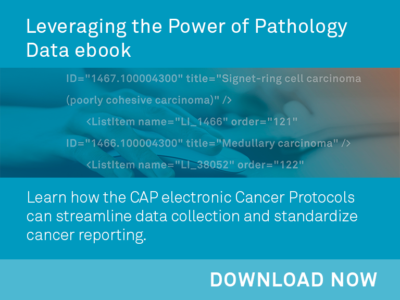- Home
- Member Resources
- Councils and Committees
- Informatics Committee
Charge
Monitor, develop, and promote best practices in health IT and information science as applied to pathology practice, including communication and terminology standards, data models, design and application of laboratory information systems and related software, and regulation of pathology data and software; educate pathologists in principles and best practices for the stewardship of diagnostic data and its integration into clinical practice; and through the Council on Informatics and Pathology Innovation provide an expert resource to the CAP to support development of informatics-related policy, position statements, guidelines, and products.
This committee reports to the Council on Informatics and Pathology Innovation (CIPI).
Membership
The committee is comprised of the Chair and Vice-Chair, 21 members-at-large; two junior members; and 12 liaisons to external organizations who may be members, staff, or non-CAP member experts. The committee may also appoint advisors from time to time. Liaisons include:
- Association for Pathology Informatics (1)
- HL7 Anatomic Pathology (1)
- HL7 Orders & Observations (1)
- HL7 Vocabulary (1)
- IHE PaLM Anatomic Pathology (2)
- IHE PaLM Lab (2)
- LOINC (2)
- SNOMED International (2)
Time Commitment
| Time Commitment Requirements | |
|---|---|
| Number of face-to-face meetings | Three |
| Length of meetings | Two consecutive days |
| Typical meeting days | Friday and Saturday |
| Meeting locations | One meeting in Chicago or DC; two meetings in other locations |
| Number of conference calls | Up to six per year as needed; one hour each |
| Hours/year of committee work required outside of meetings | Chair: 60+ hours/year and attendance at CIPI meetings and calls; Vice Chair 40+ hours/year; Other members: 24-36 hours/year and additional if presenting at conferences or attending meetings as a liaison. |
Activities of Committee
- Participate in the activities of standards development organizations important in pathology data management, including HL7, IHE, SNOMED International, and LOINC; support liaisons to these organizations who participate in and lead working groups that develop and modify data standards consistent with CAP goals in patient safety, optimization of care, and pathology practice.
- Monitor and when appropriate contribute to the activities of national consortia that form to solve problems in health IT and may include representatives from professional organizations, industry, and government; may provide representatives to support these efforts.
- Develop courses and other formal educational opportunities, online content, white papers, and peer-reviewed journal articles to meet the educational needs of pathologists, support the use of informatics standards in pathology practice, and positively influence the development of pathology informatics.
- Through the CIPI, act as an advocate and advisor to the CAP in the area of health IT; provide analysis, technical expertise, and design/implementation recommendations to CAP projects and commercial activities.
- Support the CIPI with analysis and recommendations on regulatory developments in health IT, including development and critique of written responses to government agencies’ requests.
- Survey the CAP membership to understand the use and impact of health IT in the practice of pathology.
- Develop and maintain the CAP Clinical Informatics Resource Guide as a reference for practicing pathologists and trainees.
Expertise or Experience
- Training and experience in anatomic pathology, clinical pathology, molecular diagnostics, and/or laboratory management and related domains.
- Subject matter expertise and/or experience (or, for junior members, strong interest) in one or more of the following: medical/pathology informatics, computer-based decision support, data science and machine learning, bioinformatics, computer science, health IT standards, and interoperability.
- Exposure to or experience in the development, configuration, and/or management of relevant software applications within pathology practice.
- Knowledge of regulatory requirements around health IT standards, interoperability, and/or laboratory requirements such as CLIA.
Benefits of Committee Membership
- Participate in the creation and communication of best practices in informatics, interoperability, and health IT standards that advance the field of pathology and laboratory medicine.
- Advance professionally by establishing a leadership role in health IT as applied to pathology and laboratory medicine.
- Participate in the creation and presentation of educational material and the publication of white papers and peer-reviewed articles on pathology informatics topics.
- Help define the role of the CAP in the development of pathology informatics.
- Broaden horizons in the domain and form relationships with other domain leaders.

